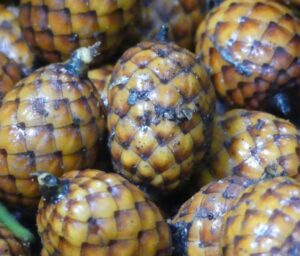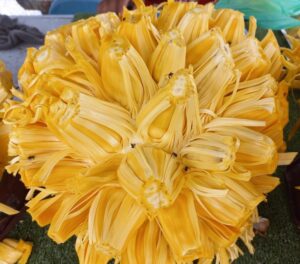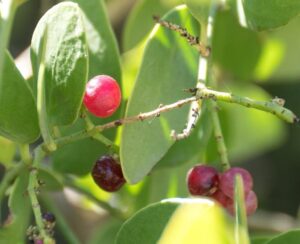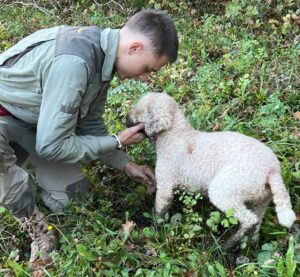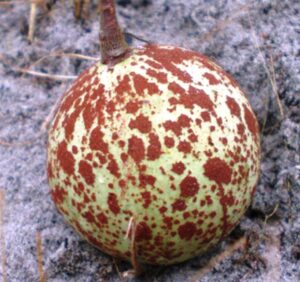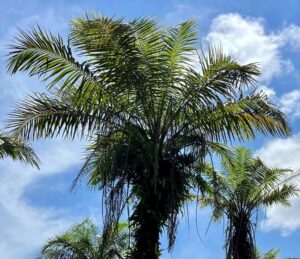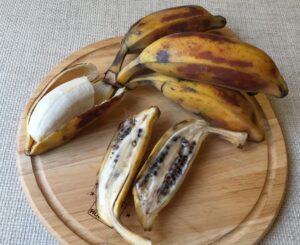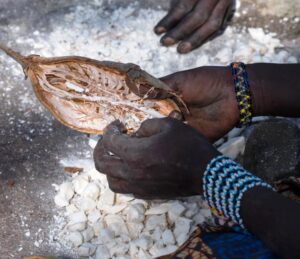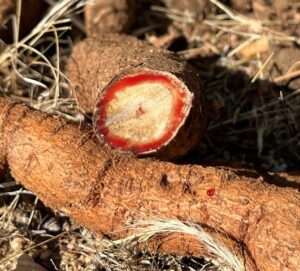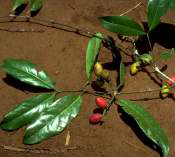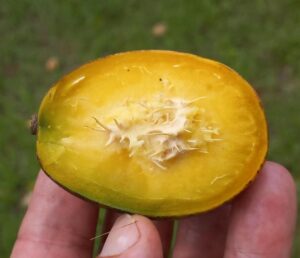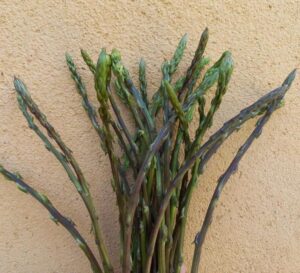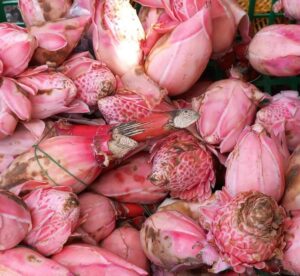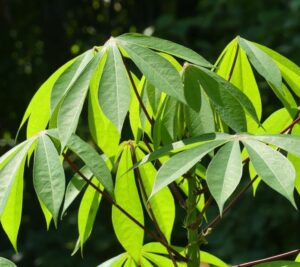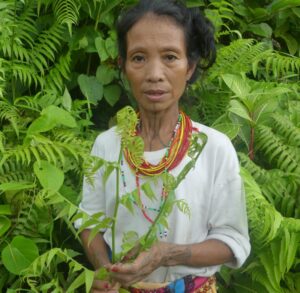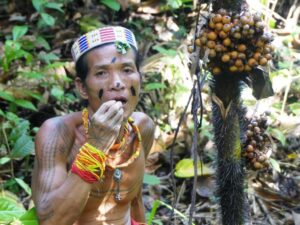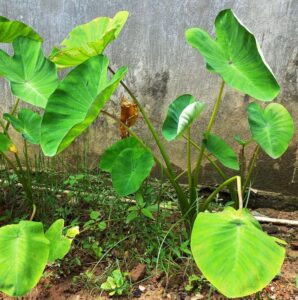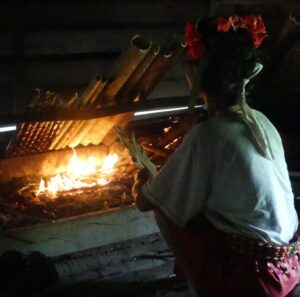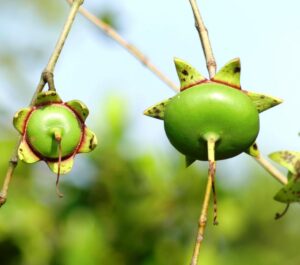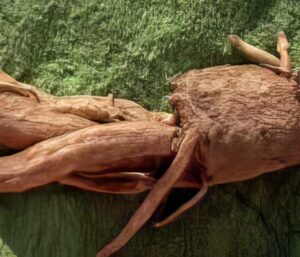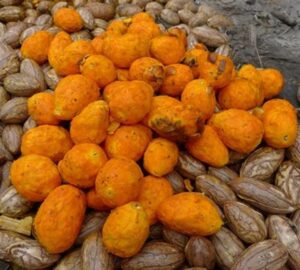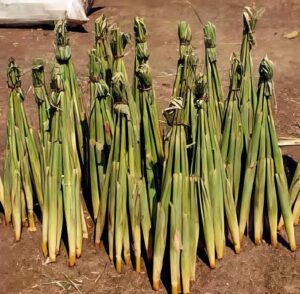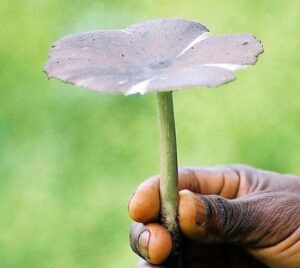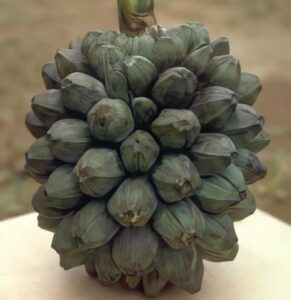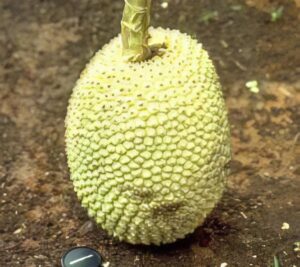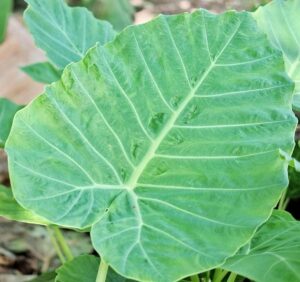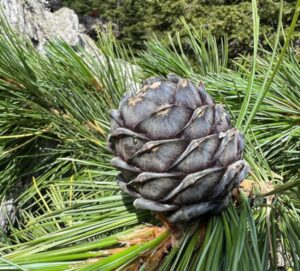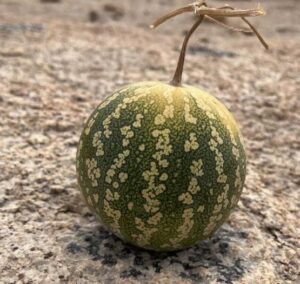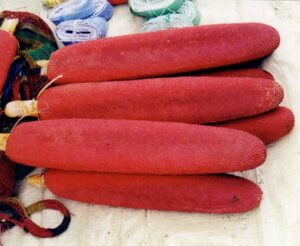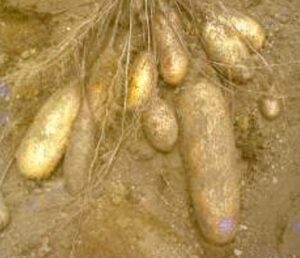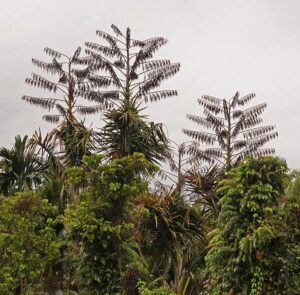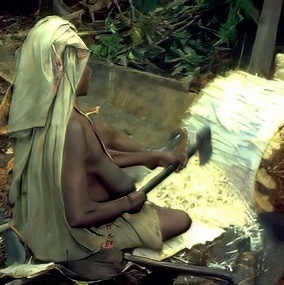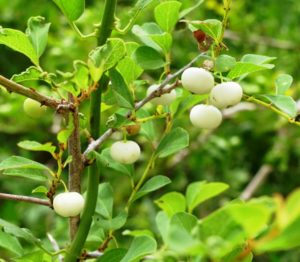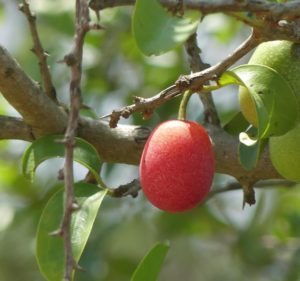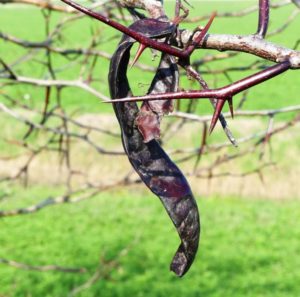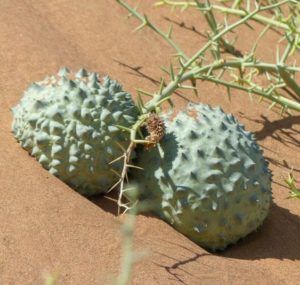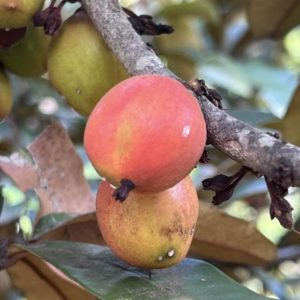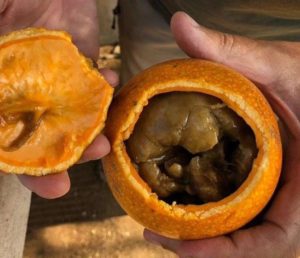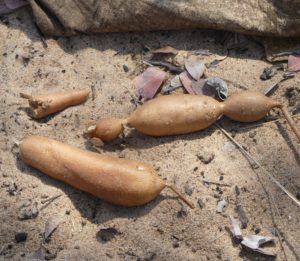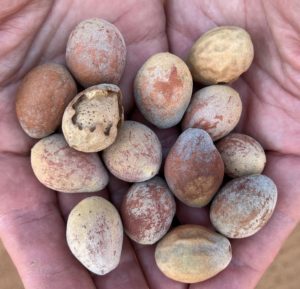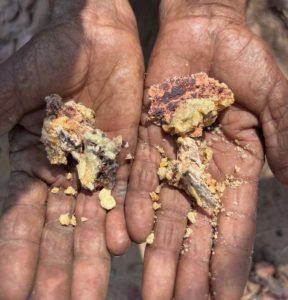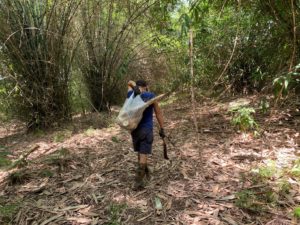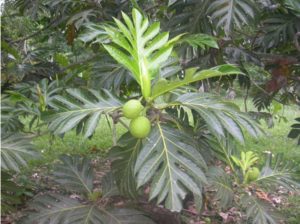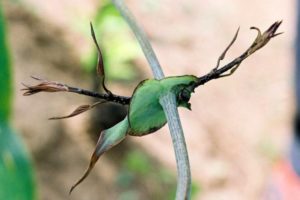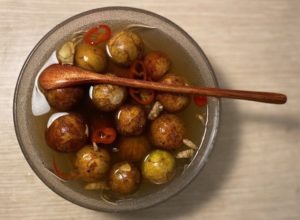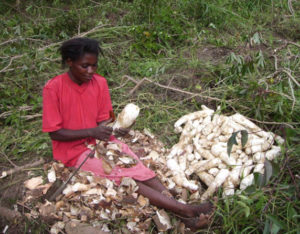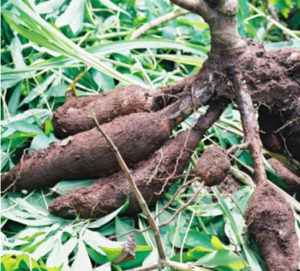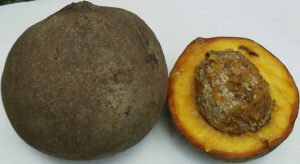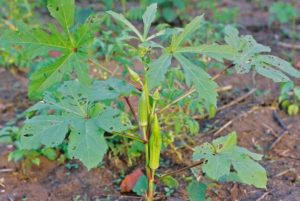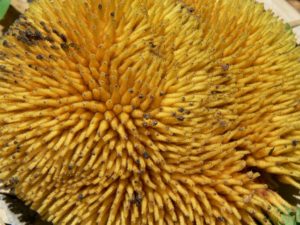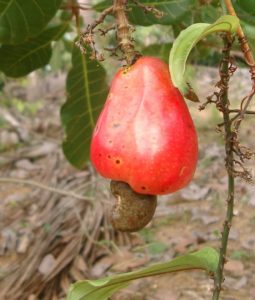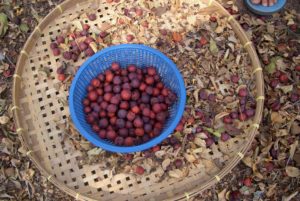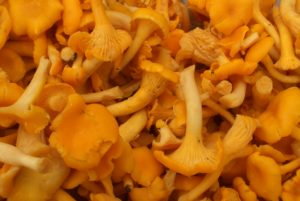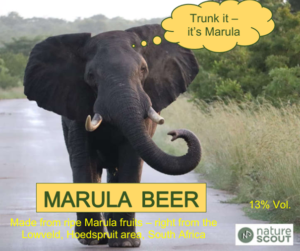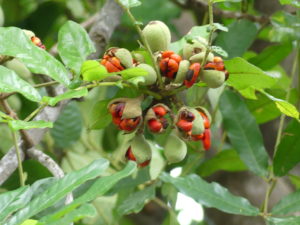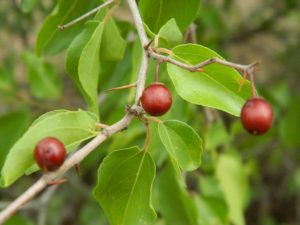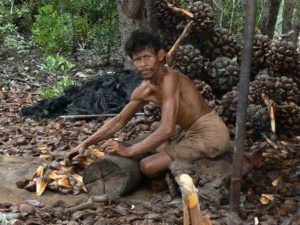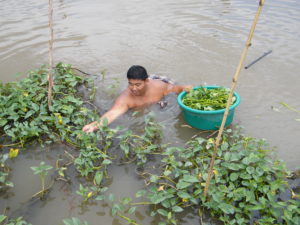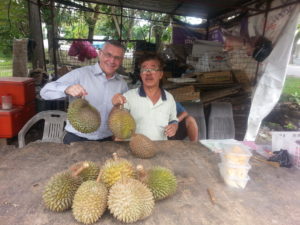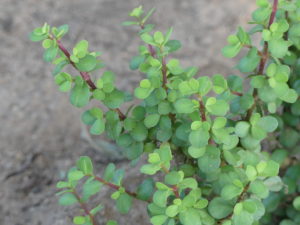Food from Plants
Fruits eaten by Mentawai people
The fruits eaten by Mentawai people in the forests are various species of bananas, coconuts, durians, and fruits from the rattan palm. Other fruits are also harvested, of which some grow wild, while others are planted and cultivated. Fruits are…
Vegetables eaten by Mentawai people
Cassava (Manihot utilissima) leaves and Fiddlehead ferns are the most essential vegetables for the Mentawai people living in the forests of Siberut Island. Both vegetables were discussed in separate articles on this webpage. Details about Cassava leaves can be found…
Carbohydrate food sources of Mentawai
Three of the four most essential food plants for Mentawai people on Siberut Island in Indonesia are carbohydrate sources. Notably, sago is a key provider, with an average composition of approximately 94% carbohydrates, about 7% moisture, and negligible other components….
Forest liana provides food and rubber
Description An extensive forest creeper growing from 20 – 50 m long, scrambling over trees and bushes at the forest edge. All parts exude white milky latex when cut. Bark is smooth and brown. It has brown tendrils up to…
Fruits eaten by Hadzabe people
Besides honey, meat, Baobab fruits, and tubers, berries are one of the significant food classes that the Hadzabe people eat. Honey is the most important one for both Hadzabe males and females. However, females relish berries as the second most…
White truffle hunting in Istria/Croatia
White truffles (Tuber magnatum) are the most highly-priced truffle species. In total, six different truffle species occur on the Istra peninsular. Four of them are variations of Black truffles (T. aestivum, T. aestivum var. uncinatum, T. melanosporum, T. brumale), and…
Edible Rubber Vine Fruits in Central Africa
Landolphia camptoloba (Apocynaceae) Common names: Mbungumbungu, dinsania, dinsona (Kongo). Magoki is also used for all Landolphia species with edible fruit. Description A slender vine or shrub growing from 30 cm to 8 m long. Mature fruits, 5 cm in diameter,…
Edible Ferns of Papua New Guinea
Some times ferns are eaten in large quantities. At highland pig kills, ferns are one of the most common edible greens. Some ferns are only eaten with meat. Some other ferns are eaten more regularly and are very much liked….
The various uses of Oil palms in D.R. Congo
Elaeis guineensis (Arecaceae); Common names Ba di nsamba, ba di ngasi (Kongo), palmier à huile (Fr.), oil palm Ecology In Kongo Central scattered trees are commonly left in the bush fallow. Propagation Seed requires heat treatment before it will germinate…
Origin of Bananas
Most areas of Papua New Guinea have bananas. Some people have them as their main staple food while in other areas they are just a snack food. There is a very large amount of variation within the banana varieties in…
Baobab seeds and pulp porridge
Baobab seeds and vine roots are staple foods for remotely living Hadza in Tanzania. This article already presented the collection and preparation of vine roots. In the following, we will discuss how to prepare Baobab seeds and their surrounding dry…
Wild Sweetpea tubers as food for Hadza people
Wild Sweetpea (Vigna frutescens) tubers are a staple source of starchy food for the Hadza people in Tanzania. The plant’s common name in the Hadza language is //ekwa. To collect them, groups of Hadza women regularly head out into the…
Tu-Lip trees in Papua New Guinea
Tok Pisin: Tu lip; Scientific name: Gnetum gnemon What does a tu-lip tree look like? It is a small tree often only 8-10 metres high. It is a fairly straight tree with one trunk that has branches spread out along…
Hog plums for food
Spondias mombin (Anacardiaceae); Common names: Mungyenge (Kongo), Hog plums Description A tree which grows to 25 m. Flowering occurs during the dry season. Fruiting of hog plums starts after about 5 years though cuttings may produce earlier. The tree has…
Ambarella fruit in the Mekong Delta
Ambarella fruit (Spondias dulcis Parkinson; syn.: Spondias cytherea) is native to Melanesia and Polynesia and was introduced worldwide throughout the tropics. Its other common English names are Jew plum and Golden apple. In the Mekong Delta, it is omnipresent in…
Wild asparagus in Sicily
Wild asparagus, a unique culinary delight, is prominent in Sicily’s springtime cuisine. The region boasts two distinct species: Asparagus albus, White asparagus, and Asparagus acutifolius, affectionately dubbed ‘Wild asparagus’ in English. Another edible part of these plants is its ‘crown’…
Ginger flowers add zest to food
Ginger flowers are eaten in many Southeast-Asian cultures. In Indonesia, most ginger varieties are known from Siberut Island. The native population of this island has utilized the flowers of Torch Ginger (Etlingera elatior (Jack) R.M. Sm.) since ancient times for…
Young Cassava Leaves provide protein and micronutrients
Young cassava leaves are a regularly eaten side dish for Mentawai people. Cassava (Manihot esculenta, Crantz) is endemic to the southern rim of Amazonia in South America. There, it was domesticated around 5000 BC. In the 16th century AC, Spanish…
Vegetable ferns are a source of nutrients in Siberut
Vegetable ferns (Diplazium esculentum (Retz.)) are among the few wild vegetables Mentawai people in the forests eat regularly on Siberut Island. By Mentawais, they are called ‘Laipat.’ Other wild vegetables are cassava leaves, ginger flowers, taro stalks, and wild eggplants….
Rattan fruits in Siberut jungles
Rattan fruits are available throughout the year in all Southeast Asian rainforests. There are about 600 different species of rattans, and many of them bear edible fruits. However, rattan prickles are a common nuisance when walking in the jungle. Nevertheless,…
Taro – another staple food of the Mentawai people
Taro (Colocasia esculenta (L.) Schott) is one of the three staple food items of the Mentawai people on Siberut Island in Indonesia. The other two are sago and bananas. In many other countries, taro leaves and corms are eaten. Mentawais…
Roasted Sago sticks on Siberut Island
Roasted sago starch is the staple food for Mentawai people living in the moist, tropical forests of Siberut Island, off the coast of Western Sumatra in Indonesia. On the other hand, sago, boiled to porridge, is eaten as a staple…
Mangrove apples at the Mekong Delta
Mangrove apples are the fruits of Sonneratia sp. trees, one of the important genera of trees in the Mangrove forests of Southeast Asia. All species of Sonneratia will develop edible Mangrove apples. The various Sonneratia species differ slightly in shape,…
Fongaar – not a yam, but kind of sweet potato
Tok ples: Fongaar Scientific name: Ipomoea macrantha Roemer & Schultes; Synonyms: Ipomoea tuba (Schlechtend.) G. Don; Plant family: Convolvulaceae What is the plant like? The plant has a long angular vine 5 to 6 metres long and it climbs up…
Raphia sese – a very special Raphia palm
Raphia sese (Arecaceae) Common names: Nsaku (Kongo = knife with a long blade), ba di magangu (Kongo). Description A palm which grows in dense clumps up to 10 m tall. Female flowers are produced at the base and male flowers…
Pitpit – Edible grasses in Papua New Guinea
Three types of pitpit grow in Papua New Guinea: Coastal pitpit The pitpit plant looks like sugarcane to which it is related. Normally the stalk is thinner than sugarcane. It can grow up to 3 metres high and produces suckers…
Some varieties of edible wild mushrooms in DR Congo
Some mushroom collectors And some sellers Bunsambi (Polyporus tenuiculus) grows on dead tree trunks (particularly Voacanga africana) and can be found throughout the year. It is cooked with simsim or seeds of pumpkin or squash. Lumvumvu (Lentinus squarrosulus) Grows on…
Wild Karuka and another pandanus fruit species
The Pandanaceae botanical family comprises the following six species in Papua New Guinea: ‘Karuka’ and ‘Marita’ were already discussed on this website in two former articles. ‘Karuka’, see here, and ‘Marita’ see there. In the following, ‘Wild Karuka’ and Pandanus…
Karuka – cultivated pandanus fruits and nuts
Tok Pisin: Karuka Scientific name: Pandanus jiulianettii Two species of pandanus are commonly used for the nuts that are eaten. They are Karuka (Pandanus jiulianettii Martelli) and wild Karuka (Pandanus brosimos Merr & Perry). At least 3 other species of…
Giant Taro – a plant with a giant root
English: Giant taro; Scientific name: Alocasia macrorrhiza (L.) Schott; Synonyms: Alocasia indica (Lour.) Spach; Plant family: Araceae Description of Giant Taro plants A very large herb of the taro family. It has a stout erect trunk up to 4 m…
Swiss pine cones and their uses
The Swiss pine (Pinus cembra) goes by different names in German-speaking countries, such as ‘Zirbe,’ ‘Arve,’ ‘Arolla pine,’ or ‘Austrian stone pine.’ For generations, people have used the nuts of this particular pine species as food during the winter months,…
Use of Tsamma melons in Namibia
Tsamma melons are the original progenitors of watermelons. Historical records indicate that these melons were already under cultivation in the Nile Valley as far back as 2000 BC. In contemporary times, Tsamma melons continue to be utilized for their oil…
Marita – a lesser known pandanus fruit
English names: Marita or ‘Red Fruit’ Tok pisin name: Marita Bahasa Indonesia name: Buah Merah Scientific name: Pandanus conoideus Lamarck The marita pandanus plant A short much branched screw pine with many prop roots. The prop roots have prickles. Trees…
Yam varieties in Papua New Guinea
Four species of yam are commonly grown and used for food in Papua New Guinea – but often naming in villages and naming by scientists do not agree. Many village people regard potato yam and 5-leaflet yam as varieties of…
Solomon’s Sago – another Sago palm species
How is this sago different? The Solomon’s sago palm that occurs in the North Solomon province and the Solomon Islands is quite different from the sago that grows in other areas of Papua New Guinea. It has a different scientific…
Sago – staple food in parts of Papua New Guinea
There are two Sago palm species in Papua New Guinea. Metroxylon sagu Rottb. and the other one occurs in North Solomons Province and the Solomon Islands. Its scientific name is Metroxylon salomonense. The sago palm plant The sago palm grows…
Sweet ‘White Berry Bush’ fruits
Synonyms White Berry bush, Snowball bush (Eng.); Witbessiesbos (Afrikaans); Chinese waterberry (China), Goowal (Yawuru Australia); Flueggea virosa (Lat.) – Flügge was a German botanist, and virosa means poisonous or having a bad odor. Distribution Flueggea virosa commonly grows in deciduous…
Sourplum fruits for food and oil
Sourplums, which belong to the Olacacea family, comprise two species: the Blue Sourplum (Ximenia americana) and the Great Sourplum (Ximenia caffra). Blue Sourplum The Blue Sourplum is naturally distributed in semi-tropical and tropical countries worldwide, as shown on the map….
Using Honey Locust Pods as Food
The Honey locust tree, also known as the Thorny locust, derives its genus name (Gleditsia) from a former director of the Botanical Garden in Berlin. Its species name (G. triacanthos) means ‘Three thorns’, which refers to the typical arrangement of…
Nara melons: Bread of the Namib desert
Nara melons were, in former times, the only food Topnaar people had available for four months (Jan – April) a year. They used conserved fruit pulp and seeds to supplement other food sources for the rest of the year. They…
Milkplum (Stamvrug) fruits grow directly out of the tree trunk
Milkplum (Englerophytum magalismontanum (Sond.) T.D.Penn). Common names: (Afr) Stamvrug. (Eng) Milkplum, Wild plum. (isiZulu) Amanumbela. (Northern Sotho) Mohlatswa. (siSwati) UmNumbela. (Tshivenda) Munombelo. (Xitsonga) Nombhela. Old name: Bequaertiodendron magalismontanum Distribution Milkplum is widely distributed from Central Africa to Botswana and Eastern…
Monkey orange, an eagerly sought-after fruit
Monkey orange is the collective common name for the fruit of at least five different Strychnos tree species, which occur from Durban/South Africa up to Western Tigray in Ethiopia. These fruits are highly delicious, and all parts of the trees…
‘Bush potatoes’ from Cowpea plants in Namibia
Cowpeas (Vigna lobatifolia) are strong climbers that resemble Mung beans. The stem of this vine is up to 6 m long and develops trifoliate leaves. Its flowers resemble purplish pea-flowers, and the pods are about. 7 – 9 cm (2…
Manketti (or: Mongongo) nuts
Manketti nuts are a staple food for a variety of people within its distribution range. And there is a strict division of naming them. Khoi-san people (Bushmen) call them ‘Manketti’, whereas Kavango people (Bantus) call them ‘Mongongo’. Both names denominate…
Wild Syringa (Burkea africana) edible tree resin
Many African trees extrude edible gums and resin. Notable Vachellia ssp. and Senegalia ssp. (old name: Acacias) are known for their edible gums. Khoi-sani people collect and eat whatever edible gums and resins they find on the go. In our…
Bamboo shoot harvesting at the Red River
With more than 70 bamboo species throughout the country, we can easily find bamboo thickets anywhere in Vietnam. Many could nurture one of the most popular and favored vegetarian foods for Vietnamese people, bamboo shoot harvesting. Two main types of…
Breadfruits (Artocarpus altilis) in Central Africa
Synonyms A. communis, A. incises; Common names Kikwa ki santu Petelo (Kongo), arbre à pain (Fr.), breadfruit Description A tree up to 35m tall produces a wide crown. All parts of the tree produce a white, bitter latex. Fruits are…
Bush Yams in Western- and Central Africa
Synonym: D. cayenensis var. praehensilis; Common names: Kisadi, sadi, Bisadi (Kongo), Igname de brousse (Fr.), bush yams, forest yam Description A sturdy climbing plant, up to 15 m long, growing from a large tuber that often protrudes from the ground….
Indochina Dragon Plums from Hanoi streets
The Indochina Dragon Plum (Dracontomelon duperreanum) is a genus of flowering plants in the family Anacardiaceae. In Vietnamese, it is called chi sấu). Dragon Plums are one of the most popular trees on the side of Hanoi streets. The fruits…
Traditional processing of cassava in Congo
Image sequence of cassava’s long way from root to market and shows the processing of cassava in its various steps Source This article is an excerpt of Paul Latham’s and Augustin Konda ku Mbuta’s books ‘Useful plants of Kongo Central…
Cassava, a staple food in Central Africa
Synonym: M. utilissima; Common names: Dyoko, Saka Saka (Kongo), Manioc (Fr.), Cassava roots Description A perennial shrub, up to 3 m high, with enlarged tuberous roots and a well-developed root system. There are many varieties, some of which are bitter…
African mammee apple in West- and Central Africa
Common names are Mafambu, Dimbu dingi (dingi = gum, resin, incense) (Kongo), Bokodji (Lingala), African mammee apple, Oboto or Djimbo (commerce). Scientific name: Mammea africana. Description A large forest tree up to 45 m tall with a straight, cylindrical trunk…
Okra plants in D.R. Congo
Okra plants (Abelmoschus esculentus): Synonym: Hibiscus esculentus Common names Dongo, Lonto (Kongo), Dongo dongo, Molenda (Lingala), Gombo (Fr.) Description An erect annual herb usually 1 – 2 m. high. Leaves are 3 to 5 lobed, spirally arranged and may be…
Marang fruits in Southeast-Asian Rainforests
There are several local names for the tree and fruits of Artocarpus odoratissimus. In English, it is simply called ‘Marang’, which is based on the Philippines’ common name for this fruit. Originally endemic to the region around Mindanao, Sarawak, Kalimantan,…
Cashew apples and -nuts in Goa, India
Cashew trees (Anacardium occidentale) are native to areas around Northeastern Brazil. Portuguese colonists brought them around 1560 to Goa, India, from where they spread to Southeast Asia and Africa. Therefore, cashew products already have a long history in Goa and…
Jujube trees at Ayutthaya in Thailand
The Ayutthaya Historical Park covers the ruins of the old city, which was founded by the Khmer in 850 AD and named after the Hindu holy city of Ajodhya. The city was destroyed by the Burmese in 1767 and has…
Chanterelle mushrooms in Thailand
Thai chanterelles, specifically Cantharellus minor, live in symbiosis with Gurjun trees (Dipterocarpus tuberculatus) in semi-deciduous Southeast-Asian forests. These trees are easily identified due to their double-winged (di-ptero) fruits with big seeds. Besides Cantharellus minor, other species of chanterelle mushrooms are…
Trunk it – it’s Marula beer!
Marula season in Southern Africa typically occurs in February of each year. When Marulas (Sclerocarya birrea) get ripe, they turn from green to yellow and fall from the female Marula trees. On the ground, they ripen fully and will start…
Natal Mahogany seed milk and its preparation
Natal Mahogany (Trichilia emetica) trees have got a dense canopy of dark green, glossy leaves, and a round outer shape of the tree silhouette. They preferably grow in moist places and riparian forests along drainage lines. Natal Mahogany is easy…
Buffalo thorn tree – an icon in Southern Africa
The Buffalo thorn tree (Ziziphus mucronata) is called in Afrikaans “Blinkblaar-wag-‘n-bietjie” for its shiny leaves and two thorns, which hold people back when getting caught by them. The shrub or tree has got distinctive zigzag branchlets with pairs of two…
Harvesting and opening Nipa Palm fruits
Nipa palms (Nypa fruticans) are a species of palms especially adapted to muddy environments of slow-moving tidal waters and mangrove forests. They occur in Asia-Pacific tropical climates. Nipa palm fruits are delicious to eat. Both the fruits and wooden parts…
Morning glory – a valuable wild vegetable in Asia
Swamp morning glory or Water spinach (Ipomoea aquatica) has various common names, like ‘Kangkong’ in Southeast Asia or ‘Kung Shin Tsai’ in China. It is a staple vegetable food throughout the Asia-Pacific region. It is deficient in calories (19 cal/100…
Heavenly Durian
The fruit Durian (Durio zibethinus) is named after the Malay word ‘Duri’ for ‘Thorn’, referring to the thorny skin, and ‘zibethinus’ obviously refers to its smell. And the most sought-after variety in Malaysia is ‘Musang King’, where ‘Musang’ means ‘Palm…
Purslane leaves as a vegetable in South Africa
Purslane (Portulacaria Afra), or ‘spekboom’ in the Afrikaans language, is a succulent plant, endemic to South Africa’s Eastern Cape province. It has light-green soft leaves and red-colored stems. The leaves can be eaten raw, as pickles, chutney, or jam, or…

